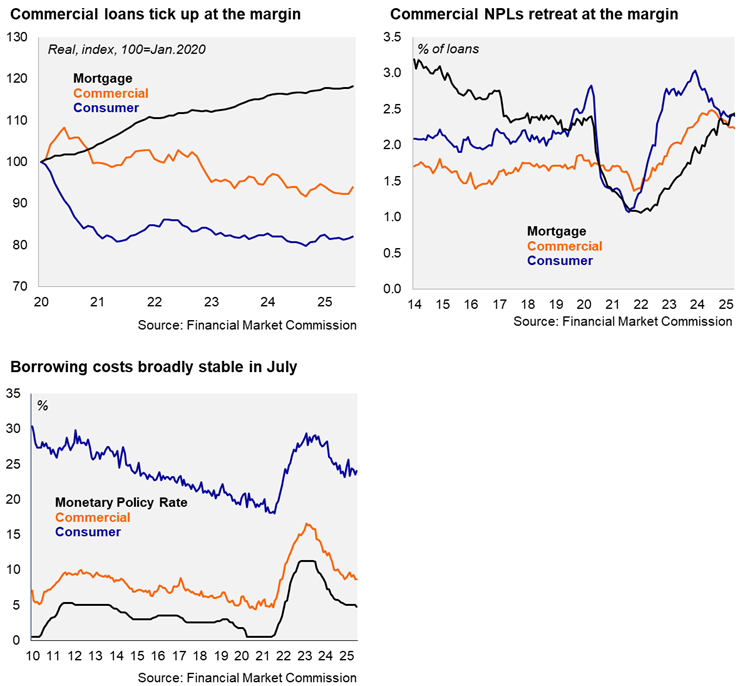2025/09/01 | Andrés Pérez M., Vittorio Peretti, Andrea Tellechea & Ignacio Martínez
According to the Financial Market Commission, the banking system’s stock of outstanding real loans in Chile fell in July, declining by 0.19% YoY (-0.56% in July 2024). Outstanding real commercial loans in Chile contracted by 1.29% in July (-2.99% in July 2024), declining on an annual basis since May 2022. Outstanding consumer loans in Chile, in contrast, rose on an annual basis again, increasing by 1.79% YoY (-0.95% in July 2024). The stock of real outstanding mortgage loans in Chile continues to gradually decelerate, rising by 1.10% YoY in June (2.27% in July 2024).
Non-performing loans (defined as delinquencies of more than 90 days) remained broadly flat at 2.30% in July (2.32% one year earlier). The banking system’s NPLs still remain well above the March 2014 – March 2020 average of 1.95%. By loan type, consumer NPLs rose slightly at the margin for the second consecutive month to 2.40% in July, from 2.43% in June (2.69% in July 2024), down from the cycle peak of 3.04% in February 2024. Mortgage NPLs continue to rise, reaching 2.44% in June (2.11% in July 2024). Commercial NPLs edged down to 2.23% (2.42% in July 2024).
Bank lending rates fell in June. According to the BCCh, interest rates in nominal terms on commercial loans rose at the margin in July to an average of 8.71, from 8.66% in June; the spread with respect to the monetary policy rate sits at 3.96pp, well below the two-year average of 4.3%. Separately, interest rates in nominal terms on consumer loans averaged 24.0% in July, up from 23.6% in June; the spread with respect to the monetary policy rate sits at 19.3pp, similar to the two-year average. Inflation-linked rates on mortgages ticked down 3bps to 4.36%.
Our take: Commercial credit in real terms continues to be below 2024 levels, but the rate of decline has moderated amid a commercial-led sequential improvement. Over time we expect the mining-led investment recovery to spillover into greater non-mining investment dynamics and appetite for credit. Borrowing costs may gradually decline going forward, considering the expectation of additional rate cuts over the upcoming quarters. Pressure on rates at the long end, stemming from global factors, should weigh on mortgage rates and hence demand. The Financial Market Commission will release bank credit data for August by the end of September.

